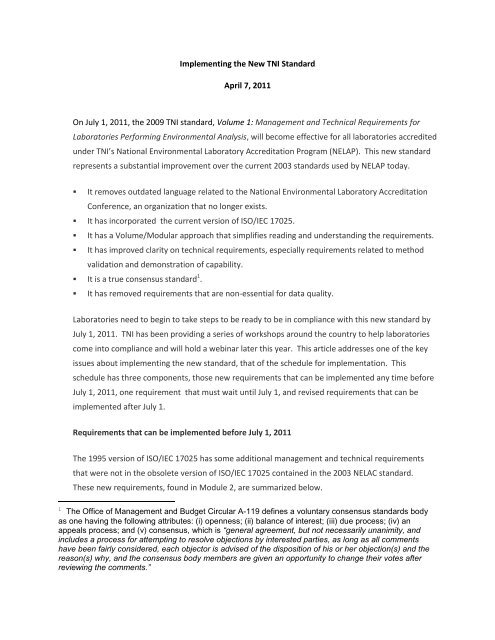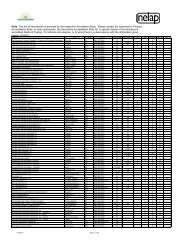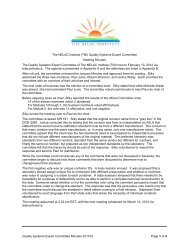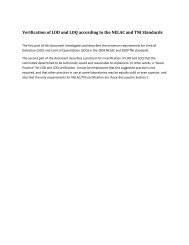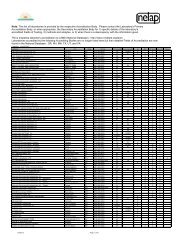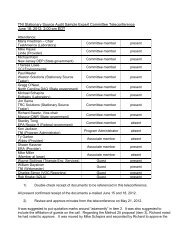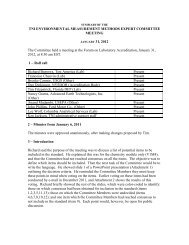Implementing the New TNI Standard - The NELAC Institute
Implementing the New TNI Standard - The NELAC Institute
Implementing the New TNI Standard - The NELAC Institute
Create successful ePaper yourself
Turn your PDF publications into a flip-book with our unique Google optimized e-Paper software.
<strong>Implementing</strong> <strong>the</strong> <strong>New</strong> <strong>TNI</strong> <strong>Standard</strong><br />
April 7, 2011<br />
On July 1, 2011, <strong>the</strong> 2009 <strong>TNI</strong> standard, Volume 1: Management and Technical Requirements for<br />
Laboratories Performing Environmental Analysis, will become effective for all laboratories accredited<br />
under <strong>TNI</strong>’s National Environmental Laboratory Accreditation Program (NELAP). This new standard<br />
represents a substantial improvement over <strong>the</strong> current 2003 standards used by NELAP today.<br />
� It removes outdated language related to <strong>the</strong> National Environmental Laboratory Accreditation<br />
Conference, an organization that no longer exists.<br />
� It has incorporated <strong>the</strong> current version of ISO/IEC 17025.<br />
� It has a Volume/Modular approach that simplifies reading and understanding <strong>the</strong> requirements.<br />
� It has improved clarity on technical requirements, especially requirements related to method<br />
validation and demonstration of capability.<br />
� It is a true consensus standard 1 .<br />
� It has removed requirements that are non-essential for data quality.<br />
Laboratories need to begin to take steps to be ready to be in compliance with this new standard by<br />
July 1, 2011. <strong>TNI</strong> has been providing a series of workshops around <strong>the</strong> country to help laboratories<br />
come into compliance and will hold a webinar later this year. This article addresses one of <strong>the</strong> key<br />
issues about implementing <strong>the</strong> new standard, that of <strong>the</strong> schedule for implementation. This<br />
schedule has three components, those new requirements that can be implemented any time before<br />
July 1, 2011, one requirement that must wait until July 1, and revised requirements that can be<br />
implemented after July 1.<br />
Requirements that can be implemented before July 1, 2011<br />
<strong>The</strong> 1995 version of ISO/IEC 17025 has some additional management and technical requirements<br />
that were not in <strong>the</strong> obsolete version of ISO/IEC 17025 contained in <strong>the</strong> 2003 <strong>NELAC</strong> standard.<br />
<strong>The</strong>se new requirements, found in Module 2, are summarized below.<br />
1 <strong>The</strong> Office of Management and Budget Circular A-119 defines a voluntary consensus standards body<br />
as one having <strong>the</strong> following attributes: (i) openness; (ii) balance of interest; (iii) due process; (iv) an<br />
appeals process; and (v) consensus, which is “general agreement, but not necessarily unanimity, and<br />
includes a process for attempting to resolve objections by interested parties, as long as all comments<br />
have been fairly considered, each objector is advised of <strong>the</strong> disposition of his or her objection(s) and <strong>the</strong><br />
reason(s) why, and <strong>the</strong> consensus body members are given an opportunity to change <strong>the</strong>ir votes after<br />
reviewing <strong>the</strong> comments.”
� Ensure personnel are aware of <strong>the</strong> relevance and importance of <strong>the</strong>ir activities and how <strong>the</strong>y<br />
contribute to <strong>the</strong> achievement of <strong>the</strong> objectives of <strong>the</strong> management system. (4.1.5 (k))<br />
� Ensure that appropriate communication processes are established within <strong>the</strong> laboratory and<br />
that communication takes place regarding <strong>the</strong> effectiveness of <strong>the</strong> management system.( 4.1.6)<br />
� Ensure <strong>the</strong> integrity of <strong>the</strong> management system is maintained when changes to <strong>the</strong><br />
management system are planned and implemented. (4.2.7)<br />
� Seek feedback, both positive and negative, from its customers to improve <strong>the</strong> management<br />
system, testing activities and customer service. (4.7.2)<br />
� Continually improve <strong>the</strong> effectiveness of its management system through <strong>the</strong> use of <strong>the</strong> quality<br />
policy, quality objectives, audit results, analysis of data, corrective and preventive actions and<br />
management review. (4.10)<br />
� Analyze quality control data and, where <strong>the</strong>y are found to be outside pre-defined criteria, take<br />
action to correct <strong>the</strong> problem and to prevent incorrect results from being reported. (5.9.2)<br />
In addition, <strong>TNI</strong>’s Quality System and Proficiency Testing (PT) expert committees revised language<br />
from <strong>the</strong> 2003 <strong>NELAC</strong> standard, and in some cases added new language, that impose new laboratory<br />
requirements. For example,<br />
� Section 4.2.1 of Module 1 requires PT samples to be analyzed every 5 to 7 months. <strong>The</strong> 2003<br />
<strong>NELAC</strong> standard required PT samples to be analyzed approximately six months apart. <strong>The</strong> new<br />
standard is not a change in <strong>the</strong> requirement, but increased clarity on “approximately six<br />
months.”<br />
� Section 5.5.13 of Module 2 provides <strong>the</strong> requirements for a daily check of support equipment<br />
such as balances, ovens and refrigerators. <strong>The</strong> 2003 <strong>NELAC</strong> standard (Section 5.5.5.2.1 of<br />
Chapter 5) used <strong>the</strong> phrase “prior to use on each working day.” <strong>The</strong> new <strong>TNI</strong> standard has<br />
revised this to read “each day <strong>the</strong> equipment is used” to clarify what was meant by “working.”<br />
Again, this is not a new requirement.<br />
� Section 5.6.4 of Module 2 now requires reagents to be traceable. This is a new requirement.<br />
All of <strong>the</strong> examples above are requirements that could be implemented by a laboratory any time<br />
before July 1, 2011 as meeting <strong>the</strong>se requirements do not conflict with any requirement in <strong>the</strong><br />
current 2003 <strong>NELAC</strong> standard.<br />
Requirement to be implemented on July 1, 2011<br />
From a thorough review of <strong>the</strong> standard by <strong>TNI</strong>’s Laboratory Accreditation <strong>Standard</strong> Executive<br />
Committee, <strong>the</strong>re is one change that must be implemented on July 1, 2011. This change relates to
eporting of PT data. Currently, PT Providers evaluate reported results to a PT Reporting Limit<br />
published in <strong>the</strong> <strong>TNI</strong> Fields of Proficiency Testing tables. This requirement has forced many<br />
laboratories to create specific reporting limits just for PT sample analyses, which is contrary to <strong>the</strong><br />
requirement that PT samples be analyzed as routine samples. <strong>The</strong> new standard allows laboratories<br />
to report results to <strong>the</strong>ir normal reporting limit for that analyte/method/matrix, and <strong>the</strong> PT Provider<br />
must evaluate <strong>the</strong> result on that basis. This change will require laboratories to provide <strong>the</strong>ir LOQ<br />
when reporting PT results. For more details, read section 5.2 of Module 1 and section 10.3 of<br />
Volume 2, <strong>the</strong> requirements for PT providers.<br />
Requirements that can be implemented after July 1, 2011<br />
<strong>The</strong> <strong>TNI</strong> expert committees that developed <strong>the</strong> new standard carefully reviewed requirements in <strong>the</strong><br />
2003 <strong>NELAC</strong> standard relative to <strong>the</strong>ir importance to ensuring data quality and integrity. A number<br />
of requirements from <strong>the</strong> 2003 standard have been modified, or in some cases deleted, to provide<br />
more flexibility in meeting <strong>the</strong> requirements or to allow laboratories to stop performing non-<br />
essential activities. For example,<br />
� Section 5.4.2.3 of <strong>the</strong> 2003 <strong>NELAC</strong> standard required laboratories to have 23 specific items in<br />
<strong>the</strong>ir Quality Manual and even specified what was to be on <strong>the</strong> cover page. Section 4.2.8 of<br />
Module 2 requires <strong>the</strong> Quality Manual to have a title and 8 specific items. It <strong>the</strong>n lists 20 items<br />
that can be in <strong>the</strong> Quality Manual or simply referenced. <strong>The</strong>re are no requirements for what<br />
must be on <strong>the</strong> cover page.<br />
� Section 5.5.6.4 of <strong>the</strong> <strong>NELAC</strong> standard required an expiration date for standards, reagents,<br />
reference materials and media. <strong>The</strong> new <strong>TNI</strong> standard (section 5.6.4 of Module 2) does not<br />
require a laboratory to fabricate an expiration date that is not provided by <strong>the</strong> manufacturer or<br />
required by a method.<br />
� Section 5.5.4.2.2 of Chapter 5 in <strong>the</strong> <strong>NELAC</strong> standard required a laboratory to document a<br />
demonstration of capability (DOC) using a form found in Appendix C and that information to be<br />
maintained in a employee training file for each analyst. <strong>The</strong> requirements DOC were very much<br />
oriented towards laboratories performing chemical analyses. In <strong>the</strong> new <strong>TNI</strong> standard, <strong>the</strong><br />
requirements for DOC are found in Modules 3-7 and vary based on <strong>the</strong> scientific discipline<br />
(asbestos, chemical, microbiological, etc.). <strong>The</strong> requirements for what must be documented are<br />
not changed, but laboratories are not required to use a specific form, and <strong>the</strong> laboratory can<br />
decide where and how to store this information.
<strong>The</strong>se three examples illustrate <strong>the</strong> increased flexibility allowed in <strong>the</strong> new <strong>TNI</strong> standard. In each of<br />
<strong>the</strong>se examples, a laboratory could continue <strong>the</strong>ir current practice and be in compliance with <strong>the</strong> new<br />
standard. And, this may be <strong>the</strong> approach to take if <strong>the</strong> system is working well. If a laboratory wants to<br />
change <strong>the</strong>ir system (e.g., quit using <strong>the</strong> Appendix C form), <strong>the</strong>y could do so. However if such a<br />
change were implemented before July 1, 2011, it would be a finding according to <strong>the</strong> 2003 <strong>NELAC</strong><br />
<strong>Standard</strong>.<br />
Implementation Plan<br />
Over <strong>the</strong> next few months, <strong>the</strong>re are a number of actions a laboratory should take.<br />
� First and foremost, get a copy of Volume 1 and read it. This article only provided a few examples<br />
of <strong>the</strong> changes. A comprehensive list of all changes is appended to this article.<br />
� If you can, plan to attend one of <strong>the</strong> <strong>TNI</strong> workshops where much more detail will be provided.<br />
� Begin implementing those new requirements that do not conflict with <strong>the</strong> current <strong>NELAC</strong><br />
standard.<br />
� On July 1, 2011, begin reporting PT data to your normal LOQ.<br />
� After July 1, 2011, consider changing your quality system to take advantage of some of <strong>the</strong><br />
increased flexibility in <strong>the</strong> new <strong>TNI</strong> standard.
Detailed Summary of Changes from 2003 <strong>NELAC</strong> to 2009 <strong>TNI</strong> <strong>Standard</strong><br />
Volume Module Section Change Discussion Laboratory Impact<br />
1 1 4.1 For laboratories applying for accreditation, last analysis<br />
of PT sample must be within 6 months of application.<br />
Minor<br />
1 1 4.1 Provision to allow PT samples to be obtained from a<br />
non-accredited provider<br />
1 1 4.2 Provision to allow PT samples to be obtained from a<br />
non-accredited provider<br />
1 1 4.2 PT sample analyses must be at least 5 and no more<br />
than 7 months apart<br />
For this to occur, a) analyte would have to be No impact<br />
approved by PT EC and NELAP AC and b) no<br />
existing PT providers are capable of providing<br />
sample.<br />
For this to occur, a) analyte would have to be No impact<br />
approved by PT EC and NELAP AC and b) no<br />
existing PT providers are capable of providing<br />
sample.<br />
Clarification of "approximately six months" Minor<br />
1 1 4.2 Provision to allow for Experimental PTs For this to occur, analyte would have to be<br />
approved by PT EC and NELAP AC<br />
1 1 4.2 Corrective action PT samples must be 15 days apart. 2003 <strong>NELAC</strong> standard required 15 days from<br />
closing date of PT study. <strong>The</strong> new <strong>TNI</strong> language<br />
uses analysis date, not study closing date.<br />
No impact<br />
1 1 5.1 Clarifications on how PT samples are to be analyzed. No change in intent from 2003 <strong>NELAC</strong> None<br />
1 1 5.2 Report PT data to LOQ. Significant change for labs that reported to PTRL. More flexibility<br />
1 1 5.3 Retain record of on-line submission of PT results Trivial<br />
1 1 6 Analyte does not have to be present in a corrective<br />
action PT sample<br />
Significant change from 2003 <strong>NELAC</strong> More flexibility<br />
1 2 4.1.5 (k) ensure personnel are aware of <strong>the</strong> relevance and<br />
importance of <strong>the</strong>ir activities and how <strong>the</strong>y contribute to<br />
<strong>the</strong> achievement of <strong>the</strong> objectives of <strong>the</strong> management<br />
system<br />
1 2 4.1.5 (h) Delete requirement that TD has to certify personnel<br />
have education/technical knowledge to perform tests<br />
(<strong>NELAC</strong> 5.4.1 .5.h)<br />
1 2 4.1.6 Ensure that appropriate communication processes are<br />
established within <strong>the</strong> laboratory and that<br />
communication takes place regarding <strong>the</strong> effectiveness<br />
of <strong>the</strong> management system<br />
1 2 4.1.7.2 Change requirement from 65 days to 35 days for<br />
reporting to AB when TD is absent<br />
Trivial<br />
<strong>New</strong> ISO 17025 language Minor<br />
See Section 5.2.5 – Management shall authorize… More flexibility<br />
<strong>New</strong> ISO 17025 language Minor<br />
Minor
Volume Module Section Change Discussion Laboratory Impact<br />
1 2 4.2.3<br />
Commitment to continually improving effectiveness of<br />
management system<br />
<strong>New</strong> ISO 17025 language Minor<br />
1 2 4.2.4<br />
Importance of meeting customer and regulatory<br />
requirements.<br />
<strong>New</strong> ISO 17025 language Minor<br />
1 2 4.2.7<br />
Ensure <strong>the</strong> integrity of <strong>the</strong> management system is<br />
maintained when changes to <strong>the</strong> management system<br />
are planned and implemented<br />
<strong>New</strong> ISO 17025 language Minor<br />
1 2 4.7.2<br />
Customer feedback required. Feedback may be a<br />
survey or a review of reports with customer<br />
<strong>New</strong> ISO 17025 language <strong>New</strong> Activity<br />
1 2 4.10 <strong>The</strong> laboratory shall continually improve <strong>the</strong><br />
effectiveness of its management system through <strong>the</strong><br />
use of <strong>the</strong> quality policy, quality objectives, audit<br />
results, analysis of data, corrective and preventive<br />
actions and management review.<br />
<strong>New</strong> ISO 17025 language Minor<br />
1 2 4.11.3 Increased emphasis on implementation of corrective<br />
actions.<br />
<strong>New</strong> ISO 17025 language Minor<br />
1 2 4.14 Follow-up required to verify corrective actions<br />
implemented<br />
<strong>New</strong> ISO 17025 language Minor<br />
1 2 5.9.2 Quality control data shall be analyzed and, where <strong>the</strong>y<br />
are found to be outside pre-defined criteria, planned<br />
action shall be taken to correct <strong>the</strong> problem and to<br />
prevent incorrect results from being reported.<br />
<strong>New</strong> ISO 17025 language None<br />
1 2 5.10.3.1 Information on uncertainty is needed in test reports<br />
when it is relevant to <strong>the</strong> validity or application of <strong>the</strong><br />
test results, when a customer's instruction so requires,<br />
or when <strong>the</strong> uncertainty affects compliance to a<br />
specification limit;<br />
<strong>New</strong> ISO 17025 language Minor<br />
1 2 4.2.8 Requirements for content of Quality Manual Only 9 items required to be in Quality Manual; o<strong>the</strong>r<br />
items may be or may be referenced. No<br />
requirements for cover page.<br />
More flexibility<br />
1 2 4.2.8.5 No requirement for a "Methods Manual." Labs must have SOPs for all test methods; <strong>the</strong>y do<br />
not have to be consolidated into a "manual."<br />
More flexibility<br />
1 2 NA Demonstration of Capability removed DOC is in modules 3-7 and varies by scientific<br />
discipline.<br />
1 2 4.11.7 Corrective action root cause analysis now clarified to<br />
apply to systematic errors<br />
1 2 5.5.13 Requires calibration of support equipment to be<br />
checked each day <strong>the</strong> equipment is used.<br />
2003 <strong>NELAC</strong> had <strong>the</strong> phrase "prior to use on each<br />
working day"<br />
More flexibility<br />
Clarification
Volume Module Section Change Discussion Laboratory Impact<br />
1 2 5.5.5 Removed requirements for date equipment was<br />
received, placed in service and condition when<br />
received<br />
More flexibility<br />
1 2 5.6.4<br />
Expiration dates for reagents in original containers not<br />
required unless provided by manufacturer<br />
More flexibility<br />
1 2 5.6.4<br />
Expiration dates for prepared reagents and standards<br />
must be on container<br />
2003 <strong>NELAC</strong> allowed dates to be in Quality Manual <strong>New</strong> Activity<br />
1 2 5.6.4 <strong>New</strong> traceability requirement for prepared reagents <strong>New</strong> Activity<br />
1 2 5.10.2 Date of test report not required to be present More flexibility<br />
1 2 5.10.2 Certification that <strong>the</strong> results meet all requirements or<br />
provide reasons and/or justification if <strong>the</strong>y do not no<br />
longer required<br />
More flexibility<br />
1 2 5.10.2 "Report cannot be reproduced except in full” is now a<br />
Note<br />
ISO 17025 language More flexibility<br />
1 2 5.10.2 Establishes default reporting requirments as "as<br />
received."<br />
More flexibility<br />
1 4 1.4 <strong>New</strong> language to allow for addition of anlaytes to a<br />
reference method.<br />
More flexibility<br />
1 4 1.5.2 Removed “must have procedures to relate LOD to<br />
LOQ”<br />
1 4 1.5.3 Sets different requirements for validation of reference<br />
methods and non-reference methods for precision and<br />
bias.<br />
1 4 1.6 Initial DOC required for all methods and analysts,<br />
except those in effect one year before applying for<br />
accreditation<br />
1 4 1.6 Form in Appendix C of 2003 <strong>NELAC</strong> not required to be<br />
used for DOC<br />
1 4 1.6 DOC Documentation not required to be in personnel<br />
file<br />
1 4 1.6 Initial DOC required if analyst does not perform method<br />
within 12 months<br />
1 4 1.6 QC sample used for DOC does not have to be from an<br />
outside source<br />
1 4 1.6 4 replicates (e.g., <strong>the</strong> 2003 <strong>NELAC</strong> requirements) is<br />
one option for initial DOC but not required<br />
1 4 1.6 It is <strong>the</strong> responsibility of <strong>the</strong> laboratory to document<br />
that o<strong>the</strong>r approaches to initial DOC are adequate.<br />
More flexibility<br />
More flexibility<br />
<strong>New</strong> Activity<br />
Documentation must be maintained More flexibility<br />
More flexibility<br />
<strong>New</strong> Activity<br />
More flexibility<br />
More flexibility<br />
More flexibility
Volume Module Section Change Discussion Laboratory Impact<br />
1 4 1.6<br />
Options from <strong>NELAC</strong> 5.5.2.6 still allowed: Single-blind<br />
sample, Initial DOC, or 4 LCSs<br />
More flexibility<br />
1 4 1.6 Ano<strong>the</strong>r option for on-going DOC added: A<br />
documented process of analyst review using QC<br />
samples. QC samples can be reviewed to identify<br />
patterns for individuals or groups of analysts and<br />
determine if corrective action or retraining is<br />
necessary.<br />
More flexibility<br />
1 4 1.6 On-going demonstration of proficiency does not have See <strong>NELAC</strong> 2003 – Analyte was never used in this Clarification<br />
to contain all analytes for which lab/analyst is qualified;<br />
must calibrate for all (V1M4, 1.6.3)<br />
section<br />
1 4 1.6 “Read and understand” requirements for test methods<br />
and quality documents deleted (<strong>NELAC</strong> 5.5.2.6)<br />
See M2 section 5.2.1 and 4.2.8.5. It may not have<br />
<strong>the</strong> words read and understand but requires<br />
education, training, experience and demonstrated<br />
skills.<br />
More flexibility<br />
1 4 1.7 Low standard must be at or below LOQ <strong>New</strong> Activity<br />
1 4 1.7 Minimum number of calibration standards changed<br />
from 2 to 3<br />
0 may be used as a calibration point More flexibility<br />
1 4 1.7 Data must be qualified for failed surrogate recoveries. 2003 <strong>NELAC</strong> said "should." <strong>New</strong> Activity<br />
1 4 NA 2003 <strong>NELAC</strong> language relating to glassware cleaning<br />
removed.<br />
More flexibility<br />
1 5 1.5 Method validation required for non-reference methods Specific for microbiology <strong>New</strong> Activity<br />
1 5 1.6 An acceptable approach for initial DOC described;<br />
o<strong>the</strong>r options possible<br />
Specific for microbiology More flexibility<br />
1 5 1.6 Options for on-going DOC described; o<strong>the</strong>r options<br />
possible<br />
Specific for microbiology More flexibility<br />
1 5 1.7 Beginning and ending filtration blank for MF now <strong>The</strong>re was a micro task group which made<br />
Clarification<br />
1 per set per series, not 1 set per filtration unit signification clarifications to M5<br />
1 5 1.7 Additional specifics on media quality control Clarification<br />
1 5 1.7 TOC and ammonia/organic nitrogen added to<br />
micro water quality requirements<br />
1 5 1.7 Recording of amount of media received no longer<br />
required<br />
Minor<br />
More flexibility
Volume Module Section Change Discussion Laboratory Impact<br />
1 5 1.7 Determination of time required to reestablish<br />
equilibrium in incubators deleted<br />
More flexibility<br />
1 5 1.7.5 <strong>The</strong>rmal preservation not required if if analysis begins<br />
within 15 minutes of collection or samples refrigerated<br />
within 15 minutes<br />
More flexibility<br />
1 5 1.7.5 Increased clarity on residual chlorine check <strong>New</strong> language makes it very clear on when this<br />
check needs to be performed.<br />
Clarification


